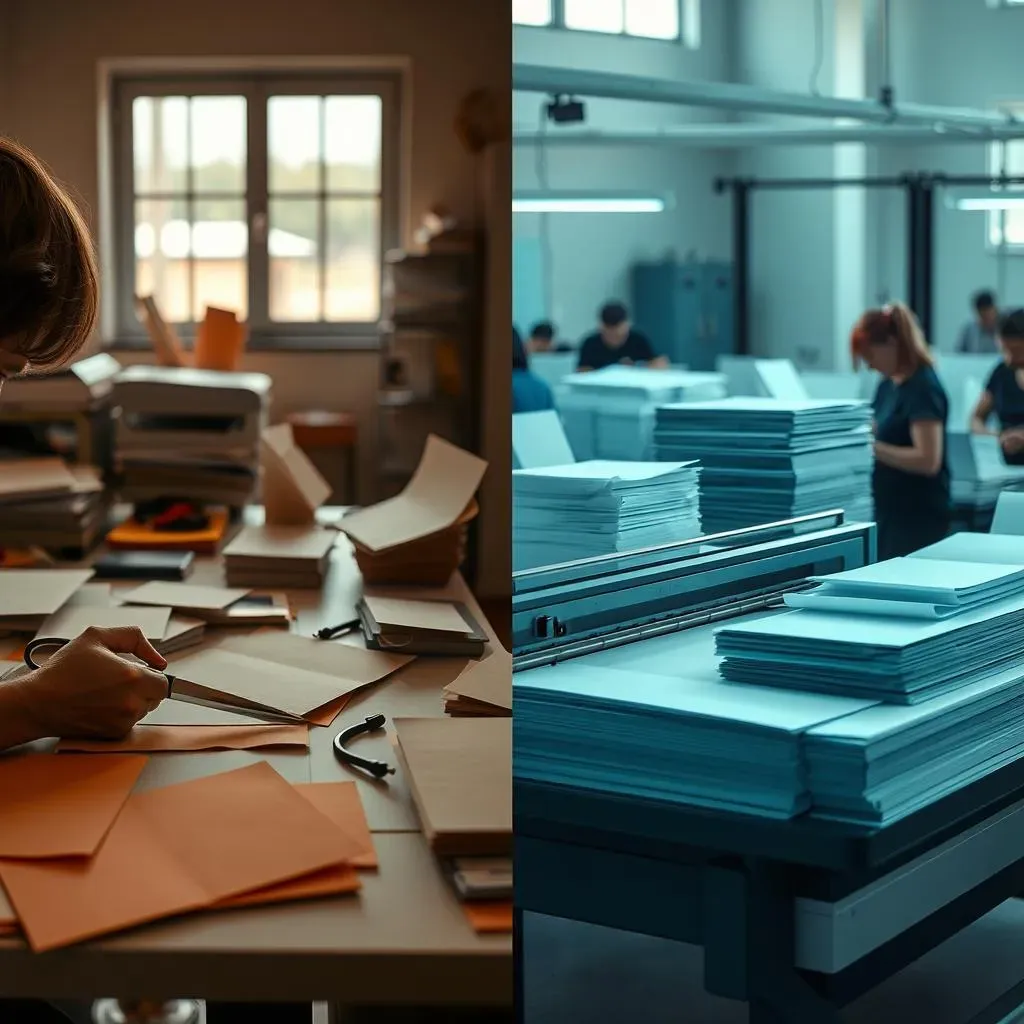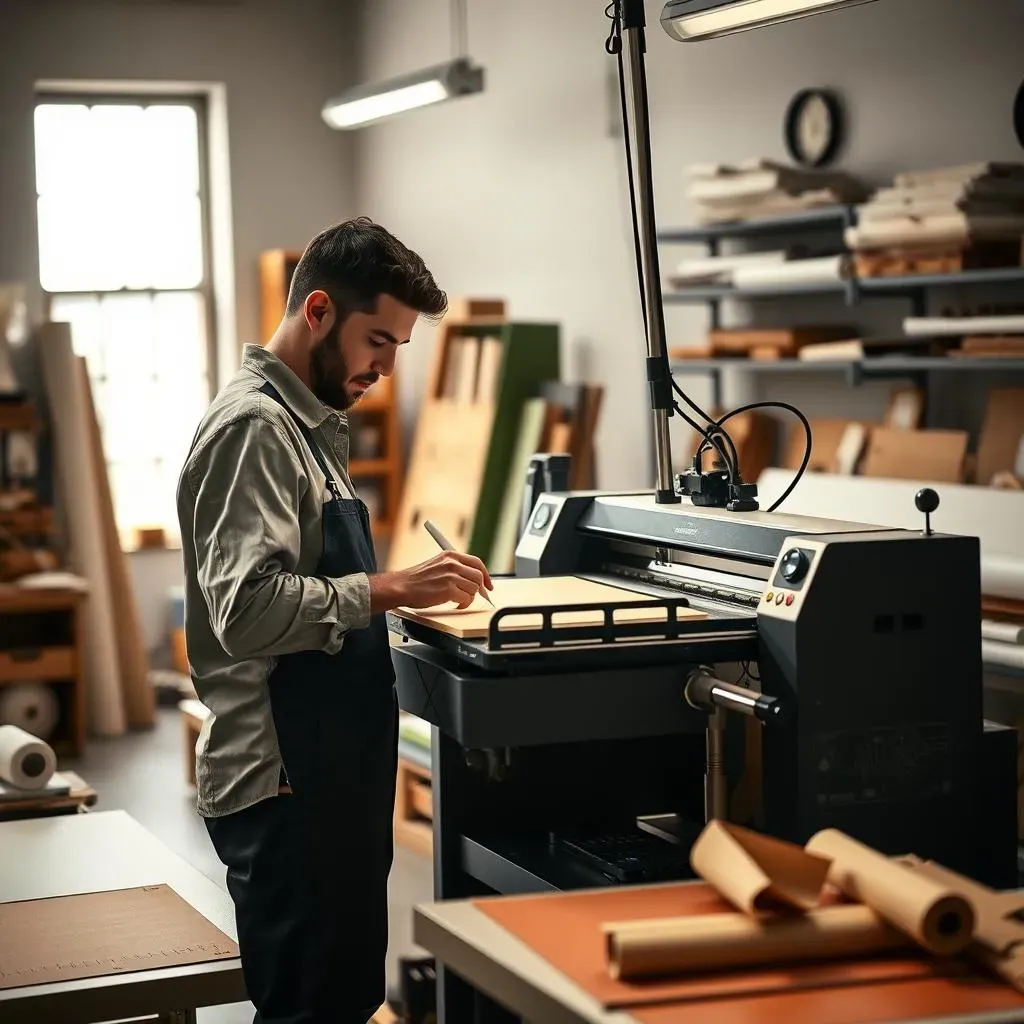Table of Contents
Ever wondered, "Who cuts paper to size?" The answer, it turns out, isn't as simple as you might think! This article is your ultimate guide to navigating the world of custom-cut paper. We'll explore the various options available, from the simple satisfaction of DIY paper cutting with everyday tools to the precision and efficiency of professional paper cutting services. We'll delve into the tools and techniques involved in creating perfectly sized paper at home, comparing the pros and cons of each method. Then, we'll examine professional paper cutting services, discussing different types of businesses that offer this service, their pricing structures, and the level of precision you can expect. Ultimately, we'll help you decide whether DIY or professional cutting is the right choice for your specific needs and project. Get ready to discover a world of possibilities, from crafting intricate paper art to preparing materials for professional printing projects. Let's explore the exciting world of custom-cut paper together!
DIY Paper Cutting: Tools and Techniques
DIY Paper Cutting: Tools and Techniques
So, you're diving into the world of DIY paper cutting? Awesome! First things first: the tools. For basic cuts, a good pair of scissors is your best friend. But, if you're aiming for precision, especially with intricate designs, consider investing in a craft knife and cutting mat. A cutting mat protects your work surface and provides a stable base for accurate cuts. For more complex projects, explore specialized tools like paper punches for creating shapes or even a rotary cutter for quick, straight lines. Remember to choose tools appropriate to the paper's thickness – heavier cardstock needs sturdier tools than thin paper. Check out this guide on choosing the right scissors for a smoother cutting experience!
Tool | Best For | Pros | Cons |
|---|---|---|---|
Scissors | General cutting, curves | Versatile, readily available | Can be less precise for intricate designs |
Craft Knife | Intricate designs, straight lines | Precise, good for detail work | Requires a cutting mat, can be dangerous |
Rotary Cutter | Straight lines, large areas | Fast, efficient | Less precise for curves |
Next up: techniques! Start with simple shapes and gradually work your way up to more challenging designs. Always use a sharp blade – dull blades tear the paper, leading to messy edges. For straight cuts, use a ruler as a guide. For curves, practice your hand movements to get a feel for how to control the blade. Don't be afraid to experiment! Paper cutting is all about letting your creativity flow. You might find some inspiration in our free paper cutting templates!
- Practice makes perfect!
- Start with simple designs.
- Use a sharp blade for clean cuts.
- Experiment with different techniques.
Remember safety first! Always cut away from yourself when using a craft knife, and supervise children when they are using sharp tools. Consider using a self-healing cutting mat to keep your work surface protected and your tools sharp. Learning to cut paper neatly can open up a whole world of creative possibilities! From delicate snowflakes to complex artwork, the possibilities are endless! And don't forget to check out our article on what is paper cutting art? for further inspiration.
"The beauty of paper cutting lies in its simplicity and the endless possibilities it offers." - Unknown
Professional Paper Cutting Services: Options and Costs
Professional Paper Cutting Services: Options and Costs
Finding the Right Professional
So, you've decided to go pro? Smart move! There are several places to find professional paper cutting services. Local print shops are often a great starting point; they frequently offer custom cutting as part of their broader services. Online marketplaces, like Etsy, can connect you with independent artisans who specialize in paper crafts and might offer custom cutting. Larger companies that deal with paper products, like packaging suppliers or stationery stores, might also provide this service. The key is to check their capabilities and pricing carefully. Don't forget to check out our guide on what you use for cutting paper to learn more about the tools involved.
- Local print shops
- Online marketplaces (Etsy)
- Paper product suppliers
Remember to always ask about their precision capabilities! Some services offer incredibly accurate cuts, measured in millimeters, while others are less precise. Consider the level of accuracy you need for your project. If you're making intricate paper models, you'll need a higher level of precision than if you're simply cutting paper for a simple project. For example, a professional might use a guillotine cutter for large quantities of paper or a laser cutter for intricate designs. Choosing the right service depends on your project's complexity and your budget.
Cost Considerations: What to Expect
Pricing for professional paper cutting varies widely depending on several factors. The size and quantity of paper you need to cut significantly impacts the cost. More complex cuts or special materials (like thick cardstock or unusual papers) will also increase the price. Some services charge a per-cut fee, while others might charge by the pound or by the project. Always get a clear quote before committing to a service. This includes checking if there are additional costs for setup, delivery, or other services. It's always good to compare prices from different providers to find the best deal for your needs. You might be surprised at the price difference between services! Take a look at our article on paper cutting machines to get a better understanding of the equipment involved.
Factor | Impact on Cost |
|---|---|
Paper Size | Larger sizes generally cost more |
Quantity | More paper means higher costs |
Complexity of Cut | Intricate designs are more expensive |
Material Type | Specialty papers cost more |
Don't hesitate to ask questions! A reputable service will be happy to answer your questions about their process, pricing, and turnaround time. Transparency is key. Before you commit, get everything in writing. This ensures you're both on the same page regarding the project's scope, cost, and delivery timeline. A clear understanding upfront prevents misunderstandings later on. It might be a good idea to check out some reviews from previous clients to get an idea of what to expect.
Beyond the Basics: Specialized Services
While many services offer standard paper cutting, some specialize in more niche areas. You might find businesses that specialize in die-cutting, a process that uses a metal die to create intricate shapes. Others might offer laser cutting for intricate designs or large-format cutting for banners or posters. Some services may even offer finishing services like folding or binding. These specialized services can be more expensive but offer unique capabilities for specific projects, such as creating custom invitations or packaging. Think about the level of customization you need to determine if a specialized service is worth the investment. For example, if you're creating unique invitations, a die-cutting service could add a level of sophistication that you couldn't achieve yourself. If you're curious about different paper cutting types, check out our article on types of paper cutting.
Remember to factor in shipping costs if you're using an online service. Shipping can sometimes add a significant amount to the overall cost, especially for larger orders. Consider the turnaround time, too. Some services offer same-day or next-day cutting, while others might take several days or even weeks. Plan ahead to ensure you get your custom-cut paper when you need it. Careful planning and research will help you find the perfect professional paper cutting service for your project.
Choosing the Right Method: DIY vs. Professional
Choosing the Right Method: DIY vs. Professional
DIY vs. Professional: Project Scope
The first thing to consider is the scale of your project. Are you cutting a few pieces of paper for a simple craft, or do you need hundreds of precisely cut pieces for a larger project, like invitations or packaging? For small, simple projects, DIY is perfectly feasible. You have complete control over the process, and the cost is minimal. However, for large-scale projects requiring precision and speed, a professional service is often more efficient and cost-effective in the long run. Think about the time commitment involved – if you have limited time, outsourcing might be a better choice. Need some ideas for simple paper crafts? Check out our article on making a paper heart without cutting!
- Small projects: DIY is great!
- Large projects: Professional might be better.
- Time constraints: Consider outsourcing.
Precision and Accuracy: The Need for Perfection
How important is precise cutting to your project? If you need perfectly straight lines and accurate dimensions, a professional service is likely the better option. Professional cutters use specialized equipment that can achieve a level of precision that's difficult to match at home. While you can achieve good results with DIY methods, especially with practice, professional services offer a higher level of consistency and accuracy, particularly for large quantities of paper. If your project demands millimeter precision, you'll want to leave it to the experts. Consider the tools you have available; a simple pair of scissors won't cut it (pun intended!) for intricate designs. For tips on choosing the best tools, see our guide on what to use for cutting paper.
Aspect | DIY | Professional |
|---|---|---|
Precision | Good with practice, but limited | High, consistent accuracy |
Speed | Slower, especially for large quantities | Fast, efficient for bulk orders |
Cost | Low upfront cost | Higher cost, but potentially cost-effective for large projects |
Budget and Time: Balancing the Scales
Finally, consider your budget and timeline. DIY paper cutting is significantly cheaper upfront, but it requires time and effort. Professional services are more expensive but can save you considerable time, especially for large or complex projects. Weigh the cost of your time against the cost of the service. If your time is valuable, outsourcing might be the more cost-effective option in the long run. Remember to factor in the cost of materials and tools if you choose the DIY route. For inspiration on intricate designs, check out our article on mastering paper cutting patterns.
Beyond the Cut: Creative Uses for CustomSized Paper
Beyond the Cut: Creative Uses for CustomSized Paper
Paper Crafts and Art Projects
Once you've got your perfectly sized paper, the creative possibilities are endless! Think intricate paper snowflakes for winter decorations, or delicate paper flowers for a spring centerpiece. Custom-sized paper is perfect for creating unique greeting cards, personalized stationery, or even miniature paper sculptures. The precision of your cuts will directly impact the overall look of your project, whether it's a simple origami crane or a complex paper model. Don't forget to check out our free paper cutting templates to jumpstart your creativity. Experiment with different paper types and textures to add depth and visual interest to your projects.
- Greeting cards
- Origami
- Paper flowers
- Scrapbooking
Professional Applications and Beyond
Beyond crafting, custom-sized paper finds its place in various professional applications. Precisely cut paper is essential for high-quality printing, packaging, and even specialized labeling. For instance, if you're creating custom packaging for your products, the exact dimensions of your paper will ensure a perfect fit. In the world of printing, precision cutting guarantees that your printed materials are the correct size and ready for use. This is particularly important for things like business cards, brochures, and flyers. Need inspiration for using your cuts? Check out our article on paper cutting frames and creative ideas! The possibilities extend even into industries like fashion and design, where custom-cut paper can be used for mockups and prototypes.
Application | Paper Size Importance |
|---|---|
Printing | Ensures accurate dimensions |
Packaging | Creates a perfect fit for products |
Labeling | Precise sizing for clear labeling |
Prototyping | Accurate representation of final product |
